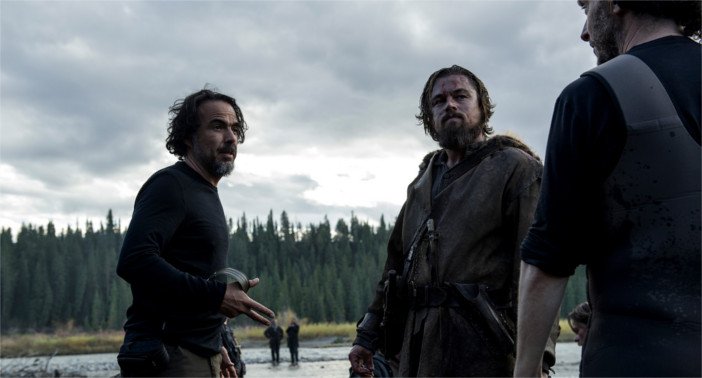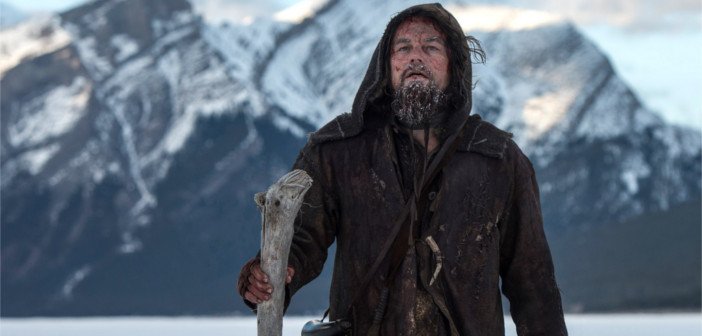Oscar Watch | Why The Revenant Should Win Best Picture
Why indeed? When Spotlight boasts gravitas in the importance of its story and Room illustrates a mesmerising strength of voice, even Mad Max claims bombastic, frenetic spectacle. Why then should a film about an inconsequential man, in a cruel and unforgiving world, which seems to marvel at adversity and revel in suffering receive the highest, critical accolade of the industry? The Revenant challenges audiences to engage with it, not just as entertainment, but on every level of its production: in its unflinching portrayal of human determination and desperation. It aims to create a commentary about film, the role of the audience in its consumption as well as those who produce it, while never yielding in its aesthetic and narrative appeal. That’s why.
The most accessible aspect of this film, undoubtedly, are its characters, thanks to strong performances throughout. Domhnall Gleeson and Will Poulter are excellent in capturing the dilemma of their morally compromising actions but Tom Hardy and Leonardo DiCaprio carry the real weight here. Hardy is, as usual, brilliantly unhinged and plays to the strength of the script embellishing his dialogue with ticks and a sinister cadence. DiCaprio however steals the show. Driven by a quiet and desperate intensity DiCaprio’s performance stands apart for his ability to visually display his reactions to the events going on around him without leaning on dialogue to directly inform the viewer as to his feelings. It’s a performance of enigmatic complexity and if he doesn’t win Best Actor I will be taking my knife and fork to the local haberdashery.

Alejandro González Iñárritu’s direction, also nominated in its own specific category, is immersive. He adds tension in the opening hunt through a continuous shot while the same technique applied in a larger conflict scene hinders the viewer’s perception of what is going on aligning their view to the perspective of the characters under attack. There are quiet contemplative moments and there are unyielding showcases where the shot refuses quarter to either editing or alternative perspectives and scenes play out to their conclusion regardless of whether or not they feature a mauling by a bear or a horse riding over a cliff face. There is an economy which pears down any superfluous narrative elements and, while by no means short, this helps to focus the story; one of revenge, while reflecting the arduous and momentous journey Glass must make to avenge the death of his son. This captures Iñárritu’s formalist approach to The Revenant where the structure of the film, the very grammar through which the plot and the story are conveyed, are not transparent agents but actively reflect and inform the events which they portray. It creates The Revenant as a singular piece of cinema which captures and plays to the unique strengths of film as a medium.
The film is also nominated in another eight technical categories which speaks to the level of detail which went into every aspect of the film. Emmanuel Lubezki’s cinematography beautifully captures the picturesque setting of the film showcasing, from afar, the lush and vast scenery that in closer quarters can be so bleakly arduous to navigate. Costume, makeup, and production design all lend themselves to the visual credibility of the films period setting while sound editing and mixing helps to convey immediacy both in and out of shot.
All of these efforts help to engage the viewer, to draw them into the world of the film and into the life and mind of the characters. This is nothing new. What makes The Revenant such a compelling film, and by far the most appropriate choice for the Best Picture award, however, is that it actively draws attention to the illusory nature of the events being presented on screen.

Continuous shots and use of CGI to stage impossible scenes could be described as somewhat contrived or brazen techniques and, while they do have an immediate narrative function, cumulatively they also highlight the constructed nature of the film itself. The camera lens is occasionally fogged by the breath of the players or splattered by blood and this brings the camera, the act of filming, and the production process actively into the film. It creates a tension throughout as if the film is at odds with itself at times drawing us into the world being presented and at other times actively hindering that immersion. This tension culminates in the final moment of the film as Hugh Glass stares down the camera, possibly at the audience, a man who has reached the end of his journey and now has nothing more to offer us. That closing shot questions the objective reality of the film while acknowledging the role of the audience as a participant. Having been voyeur to the gruelling trials of Hugh Glass he calls on us to question why exactly we’ve been watching him and reminds us that the seemingly separate worlds of the fictional are, by the act of consumption, far more connected to us then may at first be apparent.
Neither a weighty story about the tenacity of the truth nor a contemplation on the resilience on innocence The Revenant is very much more; addressing concerns about film as a medium, embracing it, and using it to not only tell a compelling story but reflect on itself and the processes which brought it into being. It might seem like an academic argument but such a preoccupation shouldn’t really bother members of the Academy, they are after all the deciders of high-cinema. The Revenant is uncompromising, gripping, and a unique untranslatable piece of cinema and that’s why it’s going to win Best Picture.
Featured Image via Variety.com

